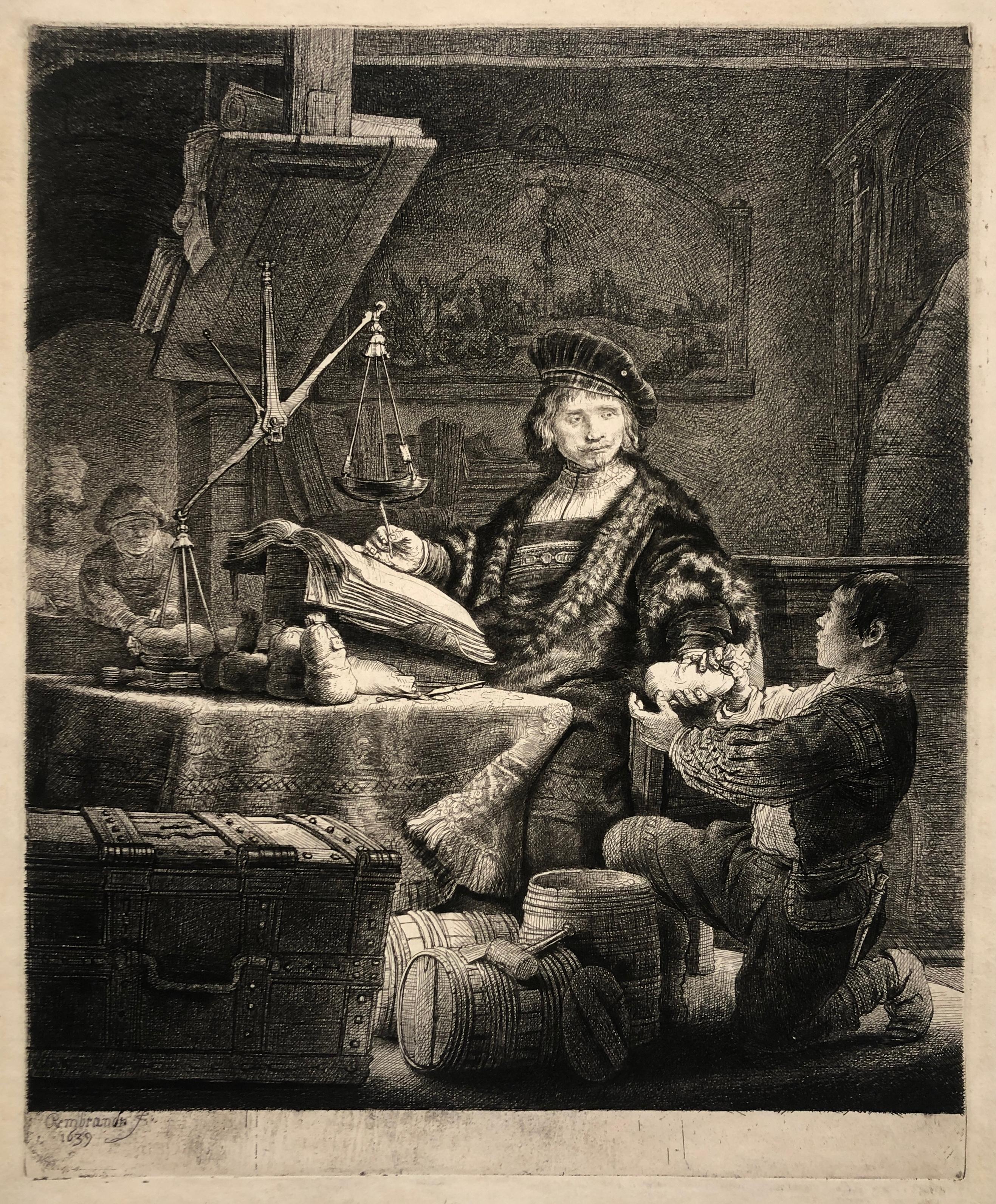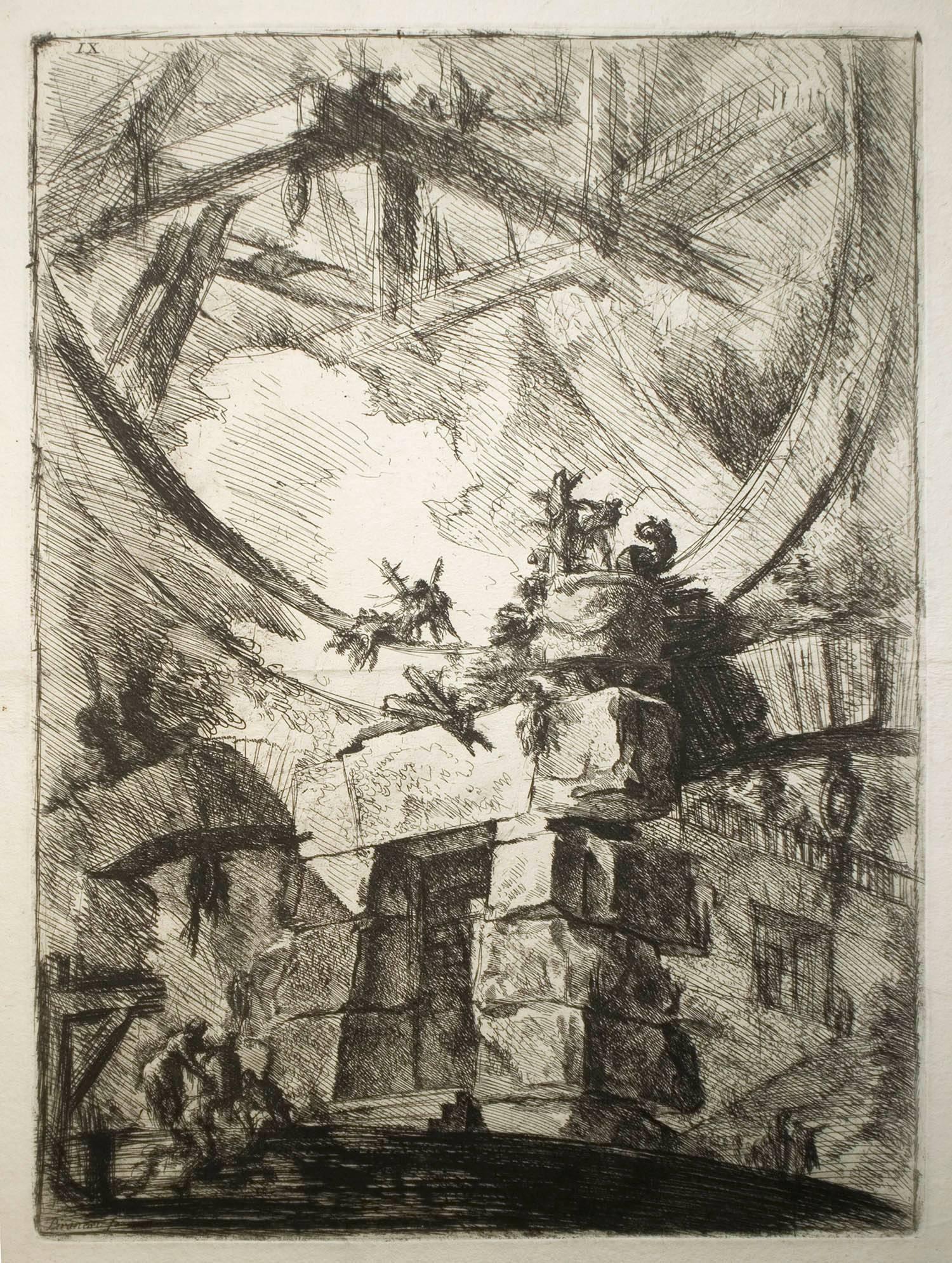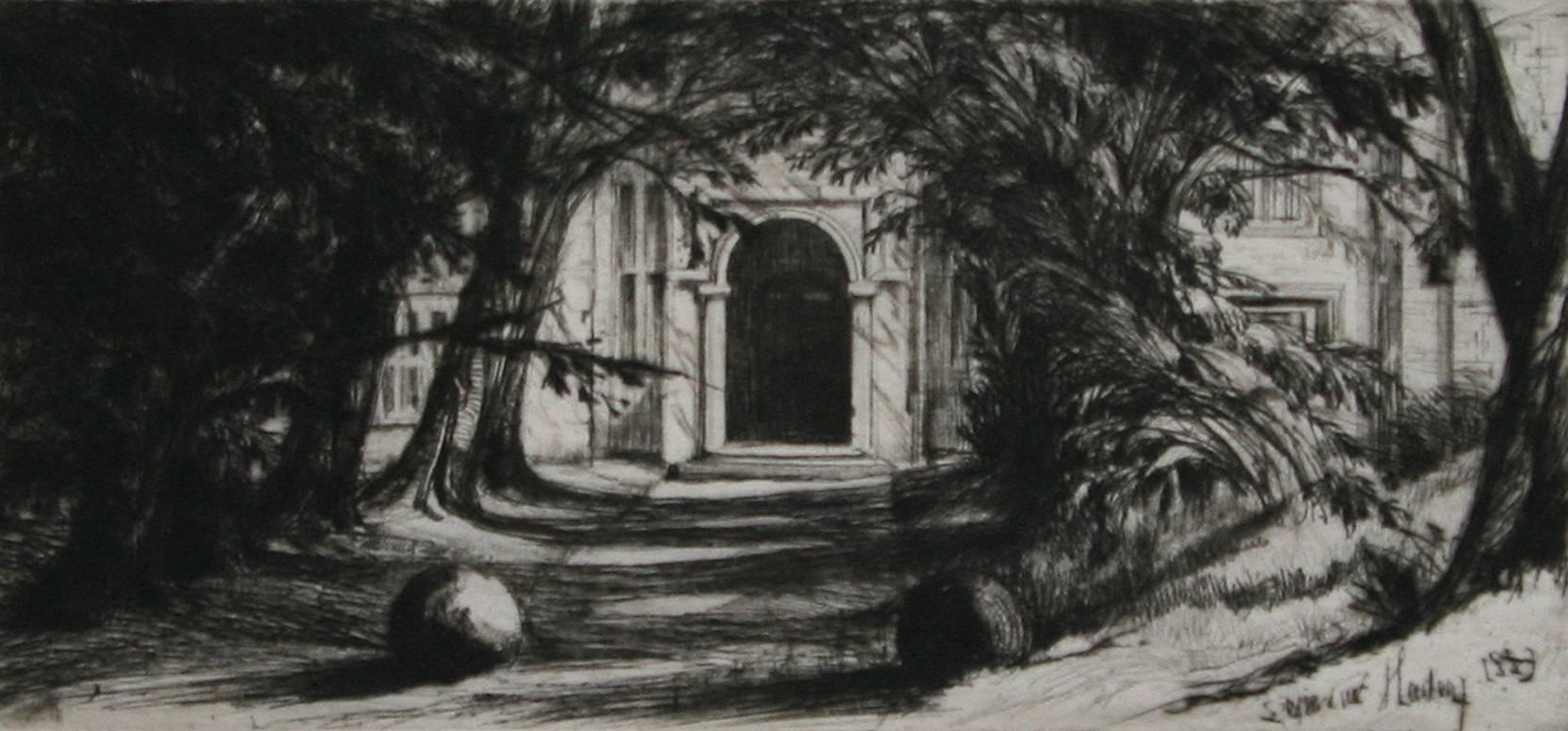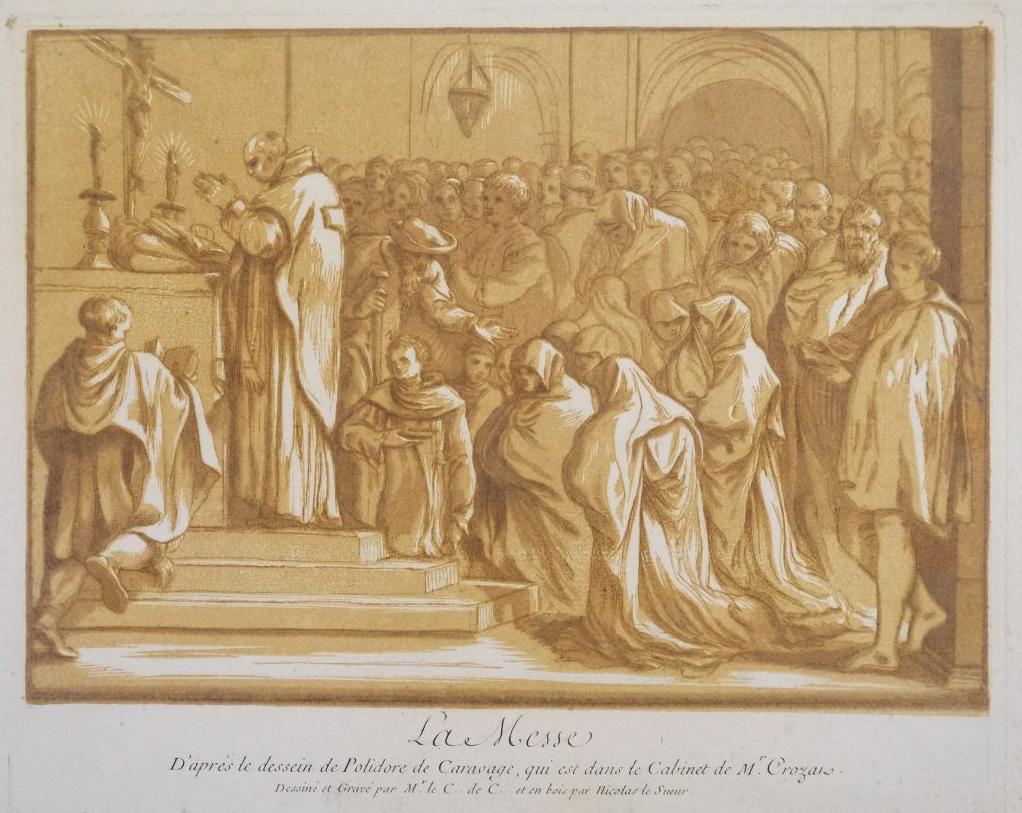Items Similar to Set of Two 18th Century Engravings from William Hogarth's "Analysis of Beauty"
Want more images or videos?
Request additional images or videos from the seller
1 of 14
William HogarthSet of Two 18th Century Engravings from William Hogarth's "Analysis of Beauty" 1753
1753
About the Item
The two plates in this set were created utilizing both engraving and etching techniques by William Hogarth in 1753, originally as illustrations of his book on aesthetics, entitled "Analysis of Beauty". Due to their popularity, these plates were later published separately. The publication line in the lower right reads: "Designed, Engraved, and Publish'd by Wm. Hogarth, March 5th 1753, according to Act of Parliament." Hogarth's original copper plates were refurbished where needed by James Heath and engravings were republished in London in 1822 by Braddock, Cradock & Joy. This was the last time Hogarth's copper plates were used for printing. Most were melted during World War I for the construction of bombs.
These large folio sized "Analysis of Beauty" engravings are presented in antiqued gold-colored frames with double mats; the outer silk mats are light brown-colored and the inner mats are dark brown. Each frame measures 27.38" x 31.25" x 1.13". There is one tiny spot in the right margin of plate 1 and another in the lower margin; the latter could be from the printing process. The prints are otherwise in excellent condition.
The "Analysis of Beauty" series is in the collection of many major museums, including: The British Museum, The Metropolitan Museum of Art, The Tate Museum, The Chicago Art Institute and The Fine Arts Museums of San Francisco.
The first engraving (Plate 1) depicts a courtyard of statues which is filled with some of the most famous works of classical sculpture. The most important sculptures are surrounded by less impressive works. The Medicean Venus (#13) is in the center with a statue of Julius Caesar (#19) to the right, elevated on a pulley with a short, overdressed Brutus stands over the falling Caesar. The Apollo Belvedere (#12) is next. A judge stands to the right with his foot on a cherub (#16). Another crying cherub holds a gallows and wipes his tears with the judge's robe.
A sphinx (#21) and the drunken Silenus (#107) are below the Venus. Michaelangelo's torso (#54) and a statue of Antonius (#6) are seen in the foreground. The Farnese Hercules (#3) and a bust of another Hercules (#4) under two statuettes of Isis are also included in the scene.
The key to these objects is included in the form of a serpentine line winding around a cone (#26), Hogarth's "Line of Beauty". For Hogarth the winding line is an essential element of beauty in art. Hogarth's theory of beauty is communicated in this plate.
Plate 2 is thought to represent the Wanstead Assembly, with the Earl of Tynley and his household. It is an adaptation of a scene in the Happy Marriage series, which complements Hogarth's Marriage à la Mode series. Hogarth scholars feel this represents Hogarth's theory about the linear presentation of attitude and action. as described in this excerpt from the text of Hogarth's "Analysis of Beauty": "Thus, as two or three lines at first are sufficient to shew the intention of an attitude, I will take this opportunity of presenting my reader (who may have been at the trouble of following me thus far) with a sketch of a country-dance, in the manner I began to set out the design; in order to shew how few lines are necessary to express the first thoughts, as to different attitudes; see fig. 71. T. p. 2, which describe in some measure, the several figures and actions, mostly of the ridiculous kind, that are represented in the chief part of plate 2. The most amiable person may deform his general appearance by throwing his body and limbs into plain lines, but such lines appear still in a more disagreeable light in people of a particular make, Ihave therefore chose such figures as I thought would agree best with my first score of lines, fig. 71.
The two parts of curves next to 71 served for the figures of the old woman with her partner at the farther end of the room. The curve and two straight lines at right angles, gave the hint for the fat man's sprawling posture. I next resolved to keep a figure within the bounds of a circle, which produced the upper part of the fat woman, between the fat man and the aukward one in the bag wig, for whom I had mad a sort of an X. The prim lady, his partner, in the riding-habit, by pecking back her elbows, as they call it, from the waste upwards, made a tolerable D, with a straight line under it, to signify the scanty stiffness of her peticoat; and a Z stood for the angular position the body makes with the legs and thighs of the affected fellow in the tye-wig; the upper parts of his plump partner was confin'd to an O, and this chang'd into a P, served as a hint for the straight lines behind. The uniform diamond of a card, was filled up the the flying dress, &c. of the little capering figure in the spencer-wig; whilst a double L mark'd the parallel position of his poking partner's hand and arms: and lastly, the two waving lines were drawn for the more genteel turns of the two figures at the hither end.
The best representation in a picture, of even the most elegant dancing, as every figure is rather a suspended action in it than an attitude, must be always somewhat unnatural and ridiculous; for were it possible in a real dance to fix every person at one instant of time, as in a picture, not one in twenty would appear to be graceful, tho' each were ever so much in their movements; nor could the figure of the dance itself be at all understood.
The dancing-room is also ornamental purposely with such statues and pictures as may serve to a farther illustration. Henry viii. fig. 72. p. 2, makes a perfect X with his legs and arms; and the position of Charles the first, fig. 51. p. 2, is composed of less-varied lines than the statue of Edward the sixth, fig. 73. p. 2; and the medal over Q. Elizabeth, as well as her figure, is in contrary; so are also the two other wooden figures at the end. Likewise the comical posture of astonishment (expressed by following the direction of one plain curve, as the dotted line in french print of Sancho, where Don Quixote demolishes the puppet shew, fig. 75, R. p. 2) is a good contrast to the effect of the serpentine lines in the fine turn of the Samaritan woman, fig. 74. L. p. 2, taken from one of the best pictures Annibal Carrache ever painted."
In the right-hand corner of the print a young wife or daughter is being told to leave the dance by a country squire who points insistently to his watch. The girl accepts a letter from her lover as she puts on her cloak.
Artist: William Hogarth (1697-1764) was an English painter, printmaker, pictorial satirist, social critic, and editorial cartoonist. Hogarth's work was extremely diverse, ranging from serious realistic paintings and portraits to satire and moralistic pieces filled with symbolism. He often communicated his moral message in a series of paintings and engravings, such as: A Rake's Progress, Marriage A-la-Mode and A Harlot's Progress. He was by far the most significant English artist of his generation and inspired a movement of English caricaturists and satirists, including James Gillray (1756-1815), Thomas Rowlandson (1757-1827), Isaac Cruickshank (1764-1811) and George Cruickshank (1792-1878). His work has been studied intensely for the greater than two and a half centuries since his death with several academic scholars focusing their careers on the analysis of every element of each of his creations.
- Creator:William Hogarth (1697 - 1764, British)
- Creation Year:1753
- Dimensions:Height: 27.38 in (69.55 cm)Width: 31.25 in (79.38 cm)Depth: 1.13 in (2.88 cm)
- Medium:
- Movement & Style:
- Period:
- Condition:
- Gallery Location:Alamo, CA
- Reference Number:
About the Seller
5.0
Platinum Seller
These expertly vetted sellers are 1stDibs' most experienced sellers and are rated highest by our customers.
Established in 2011
1stDibs seller since 2019
233 sales on 1stDibs
Typical response time: 1 hour
- ShippingRetrieving quote...Ships From: Alamo, CA
- Return PolicyA return for this item may be initiated within 7 days of delivery.
More From This SellerView All
- "Allegory of Justice": A 17th Century Old Master Engraving by van SwanenburgBy Willem van SwanenburgLocated in Alamo, CAThis old master engraving entitled "Allegorie op de Rechtspraak" is by Willem van Swaanenburg after a painting by Joachim Wtewael, published by Ch...Category
Early 1600s Old Masters Interior Prints
MaterialsEngraving
- The Heidelberg Tun: A Framed 17th Century Engraving of a Huge Wine CaskLocated in Alamo, CA"The Heidelberg Tun" is a 17th century engraving by an unknown artist. It depicts a famous huge ornamental wine cask that resided in the wine cellar of Heidelberg Castle. The cask shown here, built in 1664, is the second of four Heidelberg Tuns; the first was destroyed during the Thirty Years' War, between 1618 and 1648. This cask was built in 1664 when Karl Ludwig ordered Heidelberg cellar master...Category
Late 17th Century Old Masters Interior Prints
MaterialsEngraving
- The Card Game: An Early 17th Century Engraving by A. Voet after Cornelis de VosBy Alexander VoetLocated in Alamo, CAA 17th century engraving entitled "The Card Game" by old master artist Alexander de Voet after a painting by Cornelis de Vos, created in 1632. The pain...Category
1630s Old Masters Interior Prints
MaterialsEngraving
- Loggie di Rafaele nel Vaticano: 18th Century Hand-colored Engraving by VolpatoBy Giovanni VolpatoLocated in Alamo, CAThis is an original 18th century hand-colored copper-plate engraving by Giovanni Volpato after a drawing by Camporesi. It was the frontispiece for volume one of the rare and valuable...Category
Late 18th Century Old Masters Interior Prints
MaterialsEngraving
- Portrait of William Pitt, Earl of Chatham: Rare Framed Mezzotint after BromptonBy Edward FisherLocated in Alamo, CAThis is a large framed very rare hand-colored copperplate mezzotint engraved portrait of William Pitt, the Elder, 1st Earl of Chatham by Edward Fisher, published in London in 1779 after a painting by Richard Brompton. Pitt is depicted attired in a flowing regal appearing cape, standing in an ornate room with his left hand outstretched over a serious of manuscripts and scrolls that are laying on a table or desk to his left. The table is covered by a beautiful oriental carpet. The manuscripts include the Magna Carta, a map of the colonies, including Long Island and Staten Island, and papers entitled "A Plan for the Reconciliation between Great Britain and the Colonies", "A Motion Made in 1775 for the Recall of Troops from Boston", "A Provisional Act for Settling the Troubles in America Offered to the House of Lords in 1775", and "It is doing Nothing to repeal a few Scraps of Paper or Pieces of Parchment called Acts of Parliament. But our Business is to repeal the Ill-Will and the Animosity unfortunately now subsisting between Great Britain and North America". This engraving is held by the British Museum and the British Royal Collection Trust. This large framed mezzotint engraving is presented in a brown wood frame with gold-colored beaded inner and outer trim, and a cream-colored French mat. The frame measures 31.63" high by 26.63" wide by 0.75" deep. There are three short tears along the right edge and mild creasing in the left upper, left lower and right lower corners. It is otherwise in very good condition. William Pitt (1708-1778) was a member of the British parliament from 1735 to 1761 and prime minister from 1766 to 1768. Pitt was an advocate for the American colonies leading up to the War of Independence. He called for an amiable relationship between Great Britain and the colonies and opposed the Stamp Act and military action in America. He advocated for a withdrawal of English troops from Boston in 1775 and the settling of troubles in America, as two of his manuscripts on the table outline. Pitt's colleague, Lord Shelburne (later the Marquess of Lansdowne) shared his sympathies and after Pitt's death, signed a peace treaty with the United States in 1782. The American city of Pittsburgh, Pennsylvania is named for William Pitt, the Elder. The name originated when the conflict between the British and French over territorial claims in the Northeast were settled in 1758. General John Forbes and his British army, supported by the American colonial troops, expelled the French from Fort Duquesne (which had been constructed by the French in 1754). Forbes re-named the site for William Pitt the Elder, who at the time was a British statesman. The earliest known reference to the new name, Pittsburgh, is in a letter sent from General John Forbes to Pitt, dated November 27, 1758. Pitt's son, William Pitt, the Younger, like his father, also served as British Prime Minister. Edward Fisher (1730-1785) was born in Ireland in 1730. He was originally a hatter, but learned engraving in London. He became a member of the Incorporated Society of Artists in 1766, and exhibited there fourteen times between 1761 and 1776. He engraved more than sixty portraits. In addition to this portrait of William Pitt, Earl of Chatham, after Richard Brompton he engraved several portraits after Brompton, including George, Earl of Albemarle, as well as engraved portraits after paintings by Joshua Reynolds, including the Shakespearean actor David Garrick, Hugh, Earl of Northumberland, and Elizabeth, Countess of Northumberland and Laurence Sterne, and Hope Nursing Love, as well as Robert Brown, after Mason Chamberlin, Colley Cibber, after Jean-Baptiste van Loo, Christian VII of Denmark, after Nathaniel Dance, Simon, Earl Harcourt, after Hunter, Roger Long, after Benjamin Wilson...Category
Late 18th Century Old Masters Portrait Prints
MaterialsMezzotint
- Ancient Roman Medici Marble Vase: An 18th Century Etching by PiranesiBy Giovanni Battista PiranesiLocated in Alamo, CAThis large 18th century etching by Giovanni Battista Piranesi is entitled "Vaso antico di Marmo adornato di eccellenti Sculture si nella parte anteriere che nell' opposta, le quail r...Category
1770s Old Masters Figurative Prints
MaterialsEtching
You May Also Like
- Jan Uytenbogaert, The GoldweigherBy Rembrandt van RijnLocated in Boston, MABartsch 281, Hind 167 iii/III, Nowell-Usticke 281, iii/III. A fine impression, with burr, as retouched by Baillie in 1792. With an unidentified collectors stamp, verso.Category
17th Century Old Masters Figurative Prints
MaterialsDrypoint, Etching
- The Giant Wheel (Carceri IX), (2nd State)By Giovanni Battista PiranesiLocated in Chicago, ILThis is a second state impression from three states.Category
Mid-18th Century Old Masters Interior Prints
MaterialsEngraving, Etching
- Mytton HallBy Sir Francis Seymour Haden, R.A.Located in Storrs, CTMytton Hall. 1859. Etching and drypoint. Schneiderman catalog 19 state .iii/v. 4 13/16 x 10 5/16 (sheet 5 3/4 x 10 15/16). As published in Études à l'eau-forte XXIV. Illustrated: Guichard, British Etchers, 1850-1940. An extremely rich impression printed on fine laid paper. Signed in the plate. Housed in a 16 x 20-inch archival mat. Mytton Hall is a fifteenth century mansion house situated on the River Ribble, at Whalley near Blackburn, Lancashire. Haden used to stay there when he went salmon fishing. R. Gutekunst, the dealer who inherited the rights to sell all of Francis Seymour Haden's remaining prints upon his death, noted on the front of his catalogue in July 1911: "It may be useful to add that those impressions of Sir Seymour Haden's early and rare etchings, which were published in portfolio form in Paris in 1865-66, under the title Études à l'eau-forte have, with the exception of one or two sets, never been signed in autograph by Sir Seymour, and do not, of course, bear any stamp of any kind." Although Gutekunst had impressions of the majority of Haden's works for sale, he had no remaining impressions of Mytton Hall. Henry Taylor...Category
Mid-19th Century Old Masters Landscape Prints
MaterialsDrypoint, Etching
- Set of 3 Copper Plate Engravings, by Giovanni Battista PiranesiBy Giovanni Battista PiranesiLocated in New York, NYG. B. Piranesi in his fifties was interested in archaeology and studied in Southern Italy where he produced drawings of Greek architectureCategory
18th Century Old Masters More Art
MaterialsEngraving, Handmade Paper
- 'Jesus and the Woman at the Well, ' by Amand-Durand, EngravingBy Armand DurandLocated in Oklahoma City, OKThis early 19th century framed 35" x 31" engraving by artist Amand-Durand depcits an etching of 'Jesus and the Woman at the Well,' after the Dutch master, Rembrandt van Rijn. This poignant Biblical story is depicted by Arman-Durand in Rembrandt style...Category
Early 19th Century Old Masters Figurative Prints
MaterialsEngraving
- La Messe (The Mass), after CaravaggioLocated in Middletown, NYChiaroscuro woodcut with underlying engraving on cream laid paper, printed from two blocks in brown and olive. 10 1/4 x 12 3/4 inches (260 x 321 mm) (plate), full margins with the text printing clearly below in black ink. In very good condition with scattered surface soiling and several minor flecks of light discoloration in the margins, especially in the area of the lower right corner, well outside of image area. Unobtrusive notations in pencil in the margin and on the verso. All condition issues are consistent with age. After a drawing of the same title by Polidoro da Caravaggio...Category
Mid-18th Century Old Masters Figurative Prints
MaterialsLaid Paper, Engraving, Woodcut
Recently Viewed
View AllMore Ways To Browse
Printed Bag
3 Interior Design
Antique Engraving Plates
Century Of Progress
Engravings Set
Set Of Engravings
Country French Interiors
Antique French Interior Design
William Master
William Wills
Set Of 4 Framed Art
Antique Print Room
Framed Art Set Of 3
Set Of 16 Framed
The Antique Print Room
Engraving William
Set Of Multiple Prints French
12 Engravings




